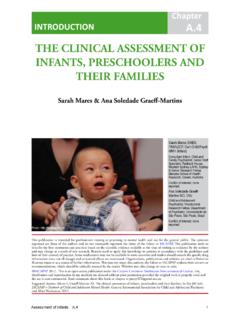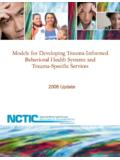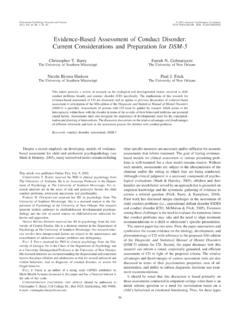Transcription of EXPLORING LOOKED-AFTER CHILDREN’S …
1 EXPLORING LOOKED-AFTER children 'S EXPERIENCES OF. child AND adolescent MENTAL HEALTH SERVICES. By Sidra Aslam Volume 1 of a thesis submitted to The University of Birmingham towards the degree of Applied Educational and child Psychology Doctorate The School of Education The University of Birmingham September 2012. University of Birmingham Research Archive e-theses repository This unpublished thesis/dissertation is copyright of the author and/or third parties. The intellectual property rights of the author or third parties in respect of this work are as defined by The Copyright Designs and Patents Act 1988 or as modified by any successor legislation. Any use made of information contained in this thesis/dissertation must be in accordance with that legislation and must be properly acknowledged. Further distribution or reproduction in any format is prohibited without the permission of the copyright holder.
2 ABSTRACT. LOOKED-AFTER children (LAC) are particularly vulnerable to poor mental health. Yet there appears to be limited research on their experiences of child and adolescent Mental Health Services (CAMHS) despite the concept of participation and being listened to strongly exemplified throughout government policy and guidance. A multiple case study design explores the lived experiences of four LOOKED-AFTER young people who have accessed CAMHS and attended a therapeutic intervention. Semi-structured interviews were conducted with four LOOKED-AFTER young people, using activities that are congruent with personal construct psychology (Kelly, 1995). Thematic analysis highlights that CAMHS as a secure base' is a facilitator to attending CAMHS. Barriers for the LOOKED-AFTER young people in attending CAMHS related to limited accessibility due to in-care factors and CAMHS factors.
3 LAC's experiences of attending a therapeutic intervention through CAMHS were positive. The overarching theme of EXPLORING trauma, loss and rejection' highlights that attending a therapeutic intervention at CAMHS supported the LOOKED-AFTER young people to process and resolve difficult past experiences and reconstruct working models of self and attachment figures. Participants also highlighted ways in which CAMHS could be improved for LAC. through a need for transparency. Implications for all professionals working with LAC are discussed. To my wonderful niece Humaira for your prayers, smiles and snacks throughout my research journey ACKNOWLEDGEMENTS. Thank you to Dr. Anita Soni for her invaluable support and advice, and thought provoking questions throughout my research journey. Thank you to Bushra for her warmth during my research journey. Finally a special thank you to the four LOOKED-AFTER young people who participated in this research study.
4 Without their honesty, openness and strength, this research would not have been possible. TABLE OF CONTENTS. Section Chapter 1: Literature Review 1. 1 Introduction to literature review 1. Aims and objectives of the literature review 1. Literature search method 2. 2 Background: Who are LOOKED-AFTER children (LAC)? 3. National policy context for improving mental health 5. outcomes for LAC. The mental health needs of LAC 6. Placement stability and mental health needs 11. Attachments and mental health of LAC 12. 3 CAMHS for LAC 14. Limitations of the research on CAMHS for LAC 17. Barriers to accessing CAMHS 18. 4 Therapeutic interventions within CAMHS 19. 5 The voice of the LAC 23. The voice of the LAC regarding mental health 25. services Methods used to explore the voice of the LAC 26. Seeking the views of LAC 28. 6 Limitations of the research 29. 7 Context for the present study 32.
5 Chapter 2 Methodology 33. 2. Introduction to methodology 33. Epistemology 33. Research design 34. Rationale for method 38. Procedure 39. Sentence completion task 41. Talking stones 42. Laddering and pyramiding of constructs 42. Pilot semi-structured interview 43. Participants 44. Documentary evidence 50. Ethical considerations 51. Reliability and validity 52. Data analysis 53. Chapter 3 Results 58. 3 Introduction to results 58. What do LAC identify as facilitators and barriers to 59. attending CAMHS? Facilitators to attending CAMHS CAMHS as a 60. secure base (i) Being available 60. (ii) Being co-operative 62. Barriers to attending CAMHS Limited accessibility 63. (i) In care factors 63. (ii) CAMHS factors 64. In what ways can CAMHS be improved for LAC? 66. Need for transparency 66. (i) Sharing information with key adults 67. (ii) Assessment process 69. What are LAC's experiences of attending a 70.
6 Therapeutic intervention from CAMHS? EXPLORING trauma, loss and rejection 71. (i) Pre care experiences 71. (ii) In care experiences 73. Emotional support 75. (i) Feeling understood 75. (ii) Understanding myself 76. Chapter 4 Discussion 78. 4 Introduction to discussion 78. Key findings 78. (i) What do LAC identify as facilitators to attending 78. CAMHS? (ii) What do LAC identify as barriers to attending 81. CAMHS? In what ways can CAMHS be improved for LAC? 83. What are LAC's experiences of attending a 86. therapeutic intervention from CAMHS? Chapter 5 Conclusion and Implications for Professional 92. Practice and Future Research 5 Introduction to discussion 92. Conclusion 92. Implications for practice 93. Critique of the methodology 99. Suggestions for future research 102. Concluding comments 104. References 105. Appendices Appendix 1 Four-tiered CAMHS framework and universal, 116.
7 Targeted and specialist services Appendix 2 Sentence completion task 117. Appendix 3 Script for talking stones' 118. Appendix 4 Laddering and pyramiding 119. Appendix 5 Social worker consent 121. Appendix 6 Foster carer information sheet and consent form 122. Appendix 7 Pupil information sheet and consent form 125. Appendix 8 Overview of ethical considerations 129. Appendix 9 Research activity timeline 132. Appendix Thematic analysis process 133. 10. Appendix Example of transcript 144. 11. List of Diagram 1 Overarching and subordinate themes 59. illustrations List of boxes Box 1 Questions for the current literature review 1. Box 2 Ten characteristics of a successful mental health 16. service for LAC. Box 3 Barriers to making contact with social workers 49. Box 4 Reducing interpreter bias 102. List of tables Table 1 Routes by which a child can become LOOKED-AFTER 3.
8 Table 2 Risk and protective factors 8. Table 3 Evidence-based interventions for LAC 22. Table 4 Components of the research design 36. Table 5 Type of consent required 46. Table 6 Selection of participants 46. Table 7 Details of the four participants in the study 50. Table 8 Case studies: validity and reliability 53. Table 9 Phases of thematic analysis 56. List of abbreviations ADHD Attention Deficit Hyperactivity Disorder CAMHS child and adolescent Mental Health Services CORC CAMHS Outcomes Research Consortium CAPA Choice And Partnership Approach EP Educational Psychologist MST Multi-Systemic Therapy LA Local Authority LAC looked after children NHS National Health Service NICE National Institute of Clinical Excellence PCP Personal Construct Psychology SCIE Social Care Institute for Excellence SDQ Strengths and Difficulties Questionnaire CHAPTER 1: LITERATURE REVIEW.
9 1. Introduction to the literature review LOOKED-AFTER children (LAC) are some of the most vulnerable and socially excluded in society (Golding, 2008). Throughout this paper, the abbreviation LAC will be used for LOOKED-AFTER children , otherwise commonly known as children in care. The term LAC will be used to refer to children and young people in care up to the age of 18. children and young people frequently enter the LOOKED-AFTER system as a consequence of abuse and neglect and bring with them a high level of need including poor mental and physical health (Mooney et al., 2009). LAC are much more likely than other children to have experienced risk factors that predispose them to the development of mental disorders (Richardson & Lelliot, 2003). There is considerable evidence of poor long-term outcomes for LAC with Mooney et al. (2009, ). calling for this area to be treated as a public health priority'.
10 The increased risk of a range of health and education difficulties has focused attention on the importance of mental health, education and social care services working closely together at all levels ( Arcelus et al., 1999; Callaghan et al., 2004; McAuley & Young, 2006; McAuley & Davis, 2009;). Aims and objectives of the literature review The purpose of the literature review is to critically review existing research on the mental health needs of LAC. Additionally, there has been limited research into the experiences and outcomes for LAC who have accessed interventions through CAMHS. This literature review will address the broad questions presented in Box 1. 1. Box 1. Questions for the current literature review 1) What does research say about the mental health needs of LAC? 2) What is the role of CAMHS for improving mental health outcomes for LAC? 3) What is the evidence base for the success of therapeutic interventions delivered by CAMHS for LAC?














